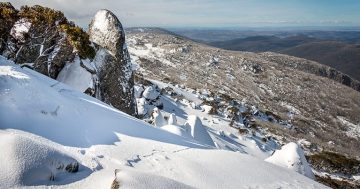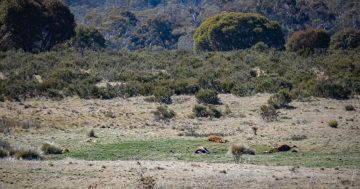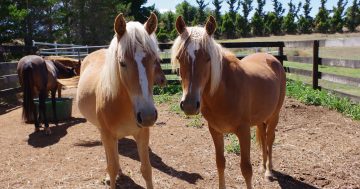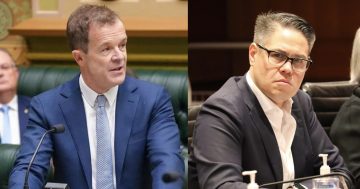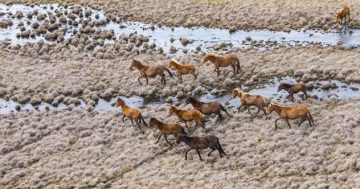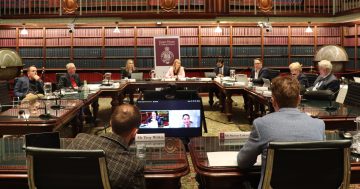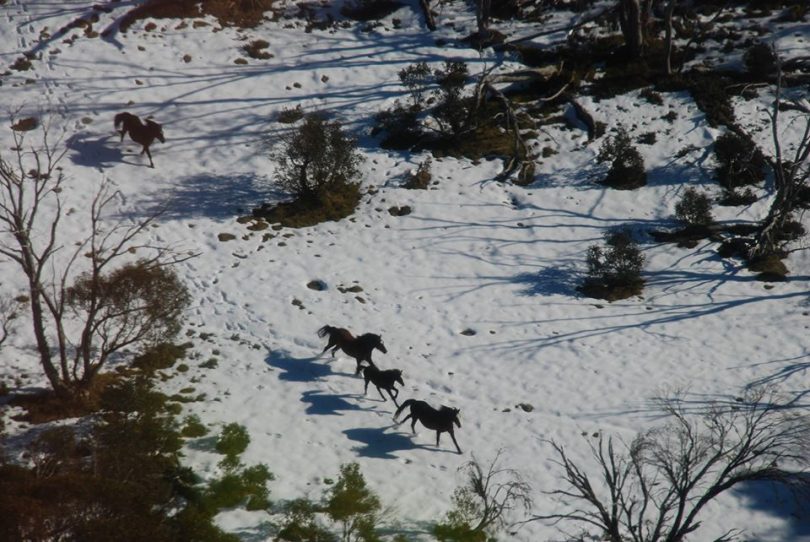
Perilous and wintery conditions await snipers and horse riders as they face off in the Victorian Alps tonight. Photo: Australian Brumby Alliance.
UPDATED, 11 PM: An application for an injunction preventing the Victorian Government from shooting any brumbies in the Victorian Alpine Country has now been filed in the Supreme Court of Victoria. This injunction application will now be heard on Monday (May 18) at 10.30 am
May 17, 8 pm: It’s a showdown with all the markings of Banjo Patterson’s colt from Old Regret, the one that got away. This weekend, a quiet insurgency is taking place in the Victorian Alps that otherwise would go unnoticed.
But for the objective.
The brumby – that wild iconic steed that divides opinions between individuals, communities, committees, politicians, conservationists, ecologists and scientists.
On one side are those who say wild horses have done immeasurable damage to fragile alpine ecosystems as their population explodes. On the other, a band of horse lovers determined to save animals they say are embedded in our heritage.
On the NSW/ACT side of the border, keen-eyed observers are watching the Victorian outcome ahead of the planned removal of 4000 horses from the northern end of Kosciuszko National Park.
And word up there in the rooftop of Australia, is that snipers are bedded down, sighting their rifles and stalking their prey in readiness for tonight’s darkness to shoot, at sight, hundreds of brumbies in Victoria’s Alpine National Park.
Those with the horse and heritage at their heart are digging in their spurs to see them saved, with experienced cattlemen and mountain riders moving into the high country to steer several mobs, including the prized Bogong brumby, with its 140-year-old bloodline, to safety.
Tonight or tomorrow – nobody actually knows when or where it’s to take place; but there are eyes to the sky, roads and the plains relaying updates down the bush telegraph.
The expected shooting cull on the Victorian side has been the most calamitous blow for brumby advocates since the May 8 federal court ruling from Justice Michael O’Bryan in favour of Parks Victoria to continue removing feral horses from Victoria’s Alpine National Park.
In bringing the action, Australian Brumby Alliance Inc. had specifically sought to stop Parks Victoria from trapping or removing any brumby in the Bogong High Plains area of the national park and, indeed, from taking action that might cause significant depletion of any of the other populations of brumbies in the national park.
But it was Justice O’Bryan’s view that, “retaining the current population of brumbies in the Bogong High Plains and Eastern Alps would not be an appropriate control of the threat they present to ecosystems, habitats and species in those alpine areas”.
That day, Parks Victoria, issued a statement welcoming the finding.
They also said that due to their inability to carry out their feral horse management plans, which include trapping and rehoming programs, for the past 18 months due to the injunction, numbers of feral horses had increased two to three times previous survey findings.
Numbers that hark back to autumn 2019, where the Australian Alps National Parks Co-operative Management Program working with Parks Victoria, NSW National Parks and Wildlife Service and ACT Parks and Conservation Service undertook a feral horse aerial survey in the Australian Alps.
Mirroring a 2014 survey, it found the estimated population of feral horses within the Australian Alps National Parks Survey area – North Kosciuszko, the Bago-Maragle and the large Byadbo-Victoria – had more than doubled in five years with the combined population estimate for the three blocks increasing from 9187 in 2014 to 25,318 in 2019.
This, they say, combined with the 2019-20 bushfires which impacted large areas of the Victorian Alps and resulted in significant loss of threatened native wildlife and ecosystems led to Parks Victoria concluding that remaining unburnt areas were being severely overgrazed and damaged by large numbers of feral horses.
“Given the current circumstances, Parks Victoria will be commencing an additional technique to control horses,” they stated.
“Small-team operations will be deployed into high-conservation priority locations where ground-based professional shooters will use thermal imaging and noise suppressors to cull free-ranging feral horses, under strict animal welfare protocols with expert equine veterinary oversight.
This will complement the current bushfire recovery works that have removed more than 1300 deer from fire impacted areas in eastern Victoria, the statement concluded.
As environmental groups applaud this action, there is conjecture about the legality of the lethal cull with brumby advocates saying this action was not among the control measures Parks Victoria’s outlined in their submissions to Justice O’Bryan.
Liberal MP Bill Tilley last week put out the call to ensure the historic Bogong Brumbies were given refuge, “until Victorian has a friendly government”.
He believes the decision to cull the brumbies is based on flawed evidence.
“Brumbies have been blamed for the damage being done by the explosion of deer in the high country,” he said, “locals will tell you that deer numbers are out of control”.
“As I have said in Parliament, it’s not the brumbies wallowing in the moss beds, nor is it the brumbies chewing and rubbing against the snow gums.
“Not brumbies but deer,” he said.
He and a band of 20 bushmen including cattleman Phil Maguire, comprising experienced mountain riders from the Snowies, Omeo, Gippsland and the Barmah have ridden into the snow strewn hills amid temperatures sitting around one degree – 11 at best – on a perilous journey through steep, rugged and dangerous terrain.
Their plan is to muster the Bogong mob to safety on private property belonging to Phil.
“It’s hard rugged country down on the sides where the brumbies spend the cold months,” Phil said, “it will be a very difficult undertaking in what might be very unpleasant conditions”.
Social media has exploded with support and reports of activity in the mountains have indicated the shooters are in place as protesters and riders have also gathered at Nunniong Plateau, Native Dog Flat and Mount Nelse, prepared stand in the open to prevent the horses from being shot.
On Friday Parks Victoria CEO Matthew Jackson said Parks Victoria has a legal and moral obligation to protect the native species at risk of extinction from the impacts of feral horses and other pest animals.
“The conservation of Alpine National Park is key to this. Native alpine plants and animals which are found nowhere else on the planet are not equipped to deal with the weight, grazing, hard hooves or trampling of feral horses.
“The 2019-20 bushfires wiped out very large areas of habitat for our unique native species. The areas less affected by fire now provide the only habitat for threatened native species and are being severely damaged by feral horses, whose numbers have significantly increased in the past five years.
“By removing large invasive herbivores from the sensitive landscape, Parks Victoria is providing a greater chance of survival for native species. Feral horse management is one component of an integrated approach to reducing the impacts of introduced animals in the Alpine National Park,” Mr Jackson said.
As late as Friday an undertaking was given by the Victorian Government to the Victorian Brumby Association that no brumbies on Bogong High Plains would be shot, but a small localised shooting operation was planned to take place tomorrow in the “severely fire impacted, high conservation area” in Victoria’s Eastern Alps.
This is an area locals say wasn’t impacted by fire because brumbies had kept the on-ground fuel load down.
Across the border, the NSW government is also facing increased pressure to cull brumbies in Kosciuszko National Park while the ACT Government says brumby numbers are destroying alpine sphagnum mosses and threaten the quality and quantity of the water supply for Canberra.
In 2018 the “Brumby Bill” legislation introduced by NSW Deputy Premier John Barilaro recognised and protected the heritage value and cultural significance of the Snowy Mountains brumby, prohibited lethal culling and allowed for the establishment of a new community advisory panel to advise the environment minister on a new management plan.
But in February 2020 the NSW Government announced around 4000 brumbies would be removed from Kosciuszko National Park as part of an emergency response to protect the alpine ecosystem after large areas were devastated by bushfires.
Three areas in the north of the park – Nungar Plain, Cooleman Plain and parts of Boggy and Kiandra plains – are being targeted for trapping and rehoming.







